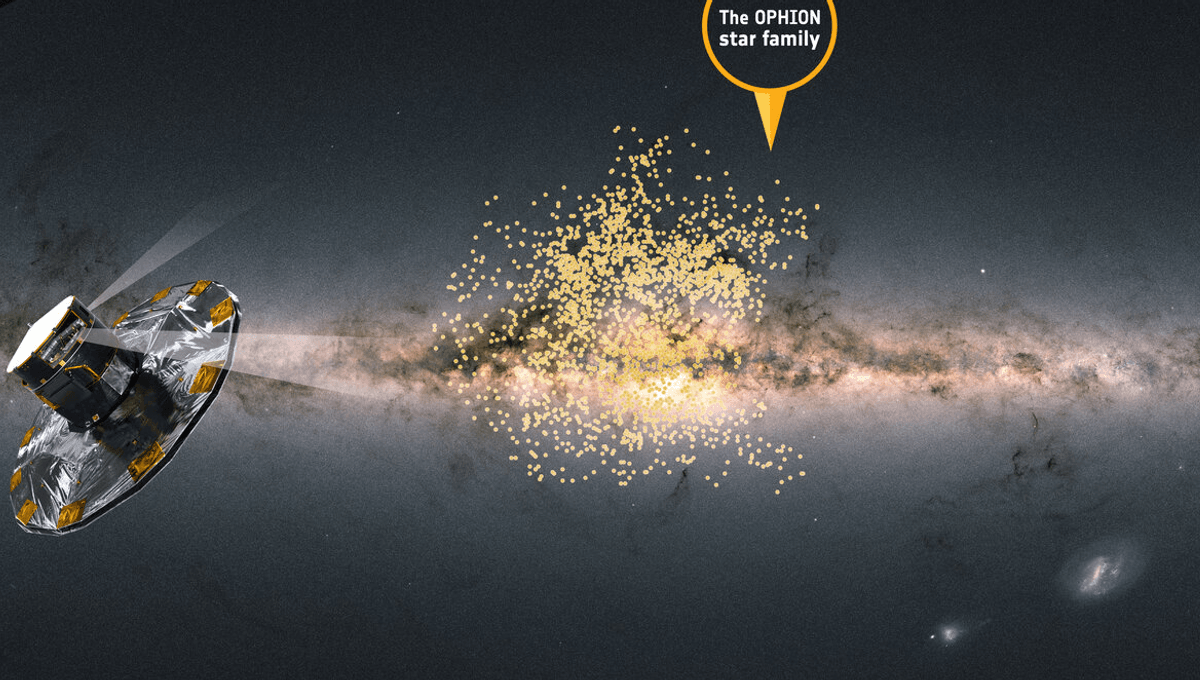
A family of stars spotted by the Gaia space telescope are behaving like none we have seen before, expanding the bounds of what we think is possible. Although two explanations have been proposed, we’re still a long way from understanding the causes of this unusual behavior.
The Gaia spacecraft ended its remarkable mission this year, but astronomers will be making use of its data for decades to come. Not many discoveries will be as unexpected as the family of more than 1,000 young stars astronomers have called Ophion.
Most stars form as part of clusters when gas clouds collapse. We can witness the process in action in the Orion Nebula, among others, as well as when the stars start to disperse in examples like the Pleiades. Astronomers refer to stars that were born together as families. Once they have been dispersed for a long time it is often not obvious that stars belong to the same family. One of the gifts Gaia gave astronomers was the data to be able to track moderately young stars back to their place of origin and identify their family.
In the case of Ophion, however, they found something quite remarkable. “Ophion is filled with stars that are set to rush out across the galaxy in a totally haphazard, uncoordinated way, which is far from what we’d expect for a family so big,” said Western Washington University student Dylan Huson in a statement. “What’s more, this will happen in a fraction of the time it’d usually take for such a large family to scatter. It’s like no other star family we’ve seen before.”
Huson and co-authors created a program to search Gaia’s data to identify young stars relatively close to the Sun that had been overlooked in previous studies because they weren’t attention-grabbing high-mass stars. Searching for stars less than 20 million years old among 220 million objects Gaia studied, they found Ophion 650 light years away in Ophiuchus.
That makes Ophion closer than M7, the cluster of stars in the neighboring constellation of Scorpius visible to the naked eye (and described by Ptolemy almost 2,000 years ago). Ophion has similar mass to M7, but because its material is distributed among lower-mass stars, it’s nowhere near as bright, and the association wasn’t noticed previously. Having already dispersed a fair way, the Milky Way as background and some dust blocking our view presumably didn’t help.
Small collections of stars separate quite quickly, because they have little gravity to bind them together and random motion can pull them apart. With more than 1,000 stars, however, Ophion applies plenty of pull on those breaking out, which nevertheless are moving at more than 20 kilometers (12 miles) a second in various directions. Stars in similar families are usually moving at a few kilometers a second at most. No stars appear to be moving coherently enough to form a lasting core after the others are gone.
“We don’t know exactly what happened to this star family to make it behave this way, as we haven’t found anything quite like it before. It’s a mystery,” said Dr Marina Kounkel of the University of North Florida. “Excitingly, it changes how we think about star groups, and how to find them. Previous methods identified families by clustering similarly moving stars together, but Ophion would have slipped through this net. Without the huge, high-quality datasets from Gaia, and the new models we can now use to dig into these, we may have been missing a big piece of the stellar puzzle.”
The authors can think of two explanations for why Ophion’s stars are flying apart like this. Either they have been disrupted by the gravity of nearby larger bodies, including the Scorpius-Centaurus family, or supernovae have given them pushes. Something so unusual probably requires a bit of each, and signs of likely former supernovae have been detected. Earthly observers would have had a treat if several supernovae exploded in a relatively short time at distances like this that are just too far away to pose a threat. Pity it probably preceded our species.
On the other hand, stars would have to be particularly massive to have gone through their cycle to become supernovae so soon after formation. Why a system would produce a few enormous stars and many of low mass, with few in between, will require investigation.
Although the discovery will set off a search for other systems like Ophion, Tolstoy’s famous quote “All happy families are alike; each unhappy family is unhappy in its own way,” may prove relevant. Judging by how keen the stars seem to be to get away from each other, Ophion is a very unhappy family indeed.
The study is published open access in The Astrophysical Journal.
Source Link: Gaia Spotted A Dysfunctional Star Family Where Everyone Is Fleeing Home